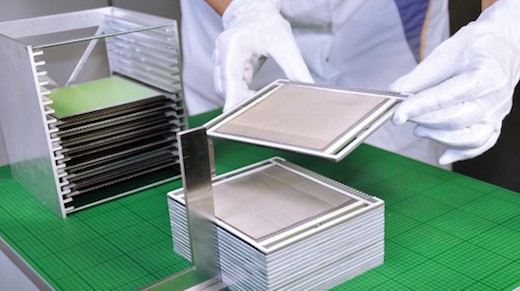
When looking into off-the-grid heating and power sources for the home, those interested might soon be getting a new option. The Dresden, Germany-based Fraunhofer Institute for Ceramic Technologies and Systems (IKTS) has joined forces with the heater manufacturer Vaillant and together they have come up with a domestic fuel cell system, which uses natural gas to produce both heat and electricity.
Fuel cells are more efficient and have lower emissions than internal combustion engines, but they have, until now, been too expensive and complicated to manufacture effectively for widespread adoption. Now, the Fraunhofer Institute has developed a domestic fuel cell, which is simple to construct and install, and also easy to maintain. It runs on natural gas.
The fuel cell system developed by Fraunhofer is based on the solid oxide fuel cell (SOFC) technology. It uses ceramic electrolyte to produce electricity as oxygen combines with hydrogen, while these fuel cells also work at a higher temperature than others. Proton exchange membrane fuel cells (PEMFCs), which are used in cars, can only reach a temperature of 176⁰ F, but SOFCs can reach a temperature of up 1,562⁰ F. In a domestic environment this high temperature can be used to keep the home warm, or to heat the water. Ceramics can withstand extreme temperatures, and can be used to manufacture these SOFCs, which in turn makes the fuel cells easier to make and cheaper to use. With other fuel cells, platinum or other precious metals act as the catalyst, which makes them more expensive.
The Fraunhofer fuel cells are very low power and produce less than a volt of electricity, meaning that they need to be placed into stacks. In a home, the SOFCs would be attached to the domestic gas supply. Upon entering the system, a reformer breaks up the gas into a hydrogen-rich mixture, which reacts with the stack in a process known as “cold combustion” that produces heat and electricity. An afterburner is also a part of this process and works to increase efficiency from the exhaust gases.
The current design of this system is only the size of a conventional gas heater and can also be installed in the same place as the gas heater. Apart from heat, it also produces 1 kilowatt of energy per cell, which is enough to sustain a family of four. They are currently testing this new heater in 150 homes across Europe as part of the Callux practice test to see how well it performs in a home. Before mass production begins, Fraunhofer and Vaillant would still like to find a way to reduce the cost of the fuel cells and increase their lifespan.
Related Articles on JetsonGreen.com:
Could Tofu be the Answer to Greener Solar Cells?
More Environmentally Friendly Solar Cells
Researchers Develop Self-Healing Solar Cells

Leave a Reply
You must be logged in to post a comment.